Small overlap front: driver-side
Rating applies to 2011-16 models
Tested vehicle: 2013 Hyundai Elantra GLS 4-door
The Hyundai Elantra was redesigned for the 2011 model year.
| Evaluation criteria | Rating |
|---|---|
| Structure and safety cage | |
| Driver injury measures | |
| Head/neck | |
| Chest | |
| Hip/thigh | |
| Lower leg/foot | |
| Driver restraints and dummy kinematics The dummy’s head contacted the frontal airbag but slid off the left side, leaving the head vulnerable to contact with forward structure. Additionally, the seat belt allowed excessive forward excursion of the dummy’s head and torso. The side curtain airbag deployed and had sufficient forward coverage to protect the head from contact with side structure and outside objects. The side torso airbag also deployed. | |
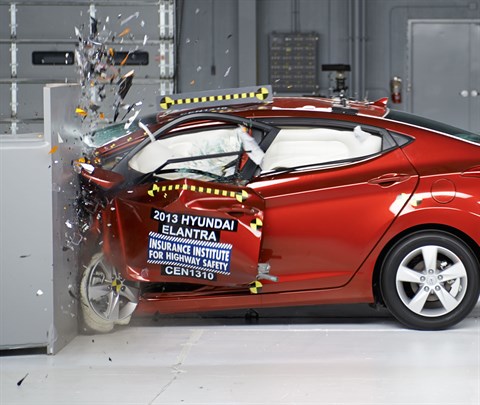
Action shot taken during the small overlap frontal crash test.
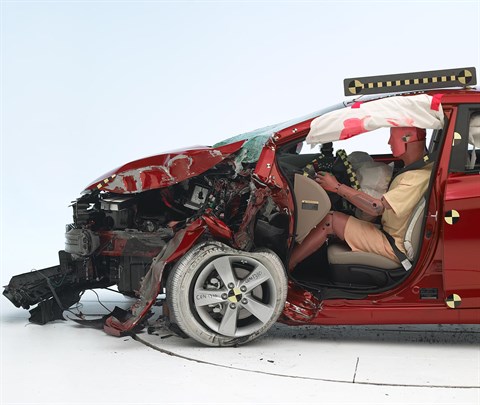
The dummy's position in relation to the door frame, steering wheel, and instrument panel after the crash test indicates that the driver's survival space was not maintained well.
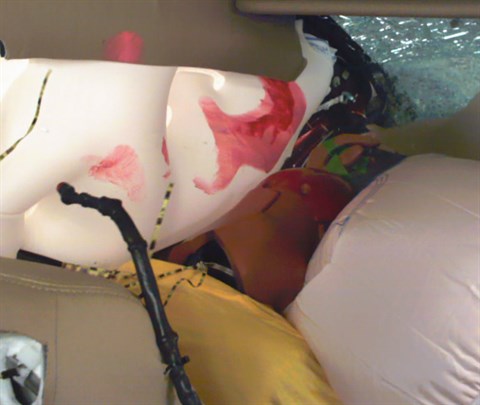
The dummy’s head contacted the frontal airbag but then slid off the left side. The side curtain airbag extended far enough forward toward the A-pillar to protect the head from contact with forward side structure. However, the seat belt allowed the dummy to move too far forward.

Despite considerable intrusion by the door hinge pillar and instrument panel, risk of injuries to the dummy's legs and feet was low.
Moderate overlap front: original test
Rating applies to 2011-16 models
Tested vehicle: 2011 Hyundai Elantra GLS 4-door
The Hyundai Elantra was redesigned for the 2011 model year. Moderate overlap frontal ratings are assigned by the Institute based on a test conducted by Hyundai.
| Evaluation criteria | Rating |
|---|---|
| Overall evaluation | |
| Structure and safety cage | |
| Driver injury measures | |
| Head/neck | |
| Chest | |
| Leg/foot, left | |
| Leg/foot, right | |
| Driver restraints and dummy kinematics | |
Side: original test
Rating applies to 2011-16 models
Tested vehicle: 2011 Hyundai Elantra GLS 4-door with standard front and rear head curtain airbags and standard front seat-mounted torso airbags
The Hyundai Elantra was redesigned for the 2011 model year. Two side tests of the Elantra were conducted, one by the Institute and the other by Hyundai. Ratings are based on both tests.
| Evaluation criteria | Rating |
|---|---|
| Overall evaluation | |
| Structure and safety cage | |
| Driver injury measures | |
| Head/neck | |
| Torso | |
| Pelvis/leg | |
| Driver head protection | |
| Rear passenger injury measures | |
| Head/neck | |
| Torso | |
| Pelvis/leg | |
| Rear passenger head protection | |
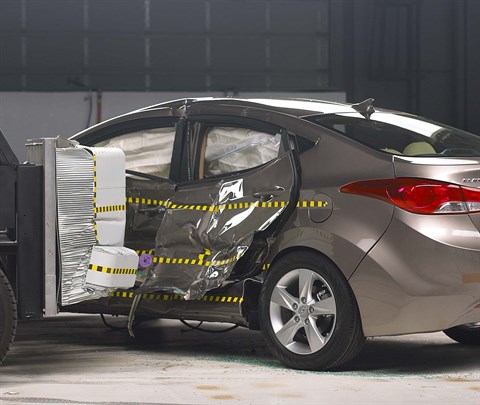
View of the vehicle and barrier just after the Institute's crash test.

View of the vehicle after the crash with doors removed, showing the side airbags and damage to the occupant compartment (Institute test car shown).

Smeared greasepaint shows where the driver dummy's head was protected from being hit by hard structures by the side curtain airbag in the Institute's test.
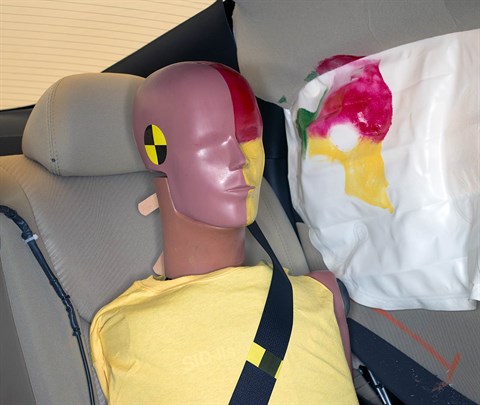
Smeared greasepaint shows where the rear passenger dummy’s head was protected by the side airbag.
Roof strength
Rating applies to 2011-16 models
Tested vehicle: 2011 Hyundai Elantra GLS 4-door
| Overall evaluation | |
|---|---|
| Curb weight | 2,748 lbs |
| Peak force | 13,933 lbs |
| Strength-to-weight ratio | 5.07 |
Head restraints & seats
Seat type: Manual cloth seat built after March 2011
| Overall evaluation | |
|---|---|
| Dynamic rating | |
| Seat/head restraint geometry |
Seat type: Manual cloth seat built before April 2011
| Overall evaluation | |
|---|---|
| Dynamic rating | |
| Seat/head restraint geometry |
About the head restraint & seat test
Currently, IIHS tests apply only to front seats.
